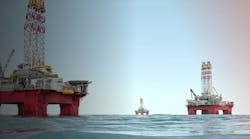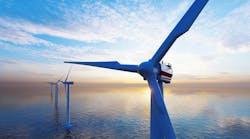Petrobras, SBM move Marlim Sul into production
Fasttrack projects that require parallel engineering and construction are becoming the norm for leased FPSO projects. This new requirement has contractors adapting work methods to meet increasingly stringent client requirements.
Speculative work on hull refurbishment and conversion can help contractors meet schedules. Unfortunately, however, spec work has a limited benefit for long lead-time items, such as topsides and turret items that usually define the project’s critical path.
Minor delays and design changes are inevitable with parallel engineering and construction, but they can be managed when the companies performing the engineering, construction management, installation, and operation are part of the same group.
Petrobras contracted such a group, SBM Offshore NV (formerly known as IHC Caland) in the construction of the deepwaterMarlim Sul FPSO, which is in the Campos basin offshore Brazil.
One of the critical components to meeting fast-track project schedules and budgets is aligning the project goals of the oil company and the contractor. A second component is good communication between the project management teams. Petrobras and SBM successfully managed both on theMarlim Sul FPSO project.
Fast-tracking Marlim Sul
Production started from Module 1 of the Marlim Sul field in December 2001, with 16 wells connected toP40production semisubmersible. Excellent reservoir performance resulted in the P40reaching capacity with only 60% of the wells connected. Restricted capacity posed a problem for Petrobras, which wanted to tie in nine additional wells. The solution was to add an FPSO to increase production capacity.
Petrobras put out a call for bids on the FPSO on a lease basis in October 2002 and awarded the seven-year plus lease contract to SBM in January 2003. SBM began design and construction work with the objective of producing first oil by the end of May 2004.
TheMarlim Sul FPSO was installed in 1,200-m water depth in the Campos basin offshore Brazil in May 2004. Production began 17 months after contract award to Single Buoy Moorings. SBM owns and operates the FPSO, which is leased to Petrobras on a long-term contract.
Meeting the FPSO delivery schedule specified in the contract required a fast-track project execution plan. The schedule necessitated parallel activities between engineering and construction and between construction and commissioning. Many engineering and procurement decisions had to be anticipated prior to their finalization to meet project milestone dates. Although this approach resulted in a certain amount of rework, concurrent plan execution proved essential to achieving the delivery times specified.
There was no front-end engineering and design phase prior to contract award for the design, supply, installation, and operation of theMarlim Sul.
SBM entered into final contract negotiations with Petrobras in late December 2002, and the contract was awarded Jan. 20, 2003, so there was very little time available for pre-award engineering or project-specific setup activities. Therefore, SBM found it necessary to rely on pre-engineered solutions from previous projects.
Refurbishing on speculation
The major pre-award activity consisted of purchasing a 285,000-dwt very large crude carrier (VLCC), theT/T Thalassa, and beginning vessel refurbishment activities on speculation before the vessel was even nominated for the Marlim Sul project.
In January 2001, SBM contracted Dubai Drydocks to refurbish the VLCC that would be required regardless of the final client, location, or topsides requirements. The schedule for completing the preliminary refurbishment work changed over time, depending on the bidding schedules for candidate FPSO projects and the availability of manpower resources.
Dubai Drydocks carried out asbestos removal, boiler tube inspection and replacement, hull blasting and painting, pipe removal, structural steel strength and fatigue analysis, structural steel replacement, and marine equipment inspection and refurbishment.
When Petrobras awarded SBM the contract for the FPSO in January 2003, the vessel was towed from Dubai to Keppel Shipyard in Singapore, where conversion work took place.
The vessel arrived on April 1, 2003, and the remaining refurbishment activities and conversion work began immediately.
The major tasks performed in Singapore included:
• Fitting support structures for the 16 topsides modules
• Fitting the five interconnecting central pipe rack modules and flare tower
• Installing a new aft helideck and two new deck cranes
• Converting the boiler to tri-fuel operation (gas/diesel/fuel oil)
• Extending the accommodation block and rearranging existing rooms to provide additional cabin and office space
• Installing and integrating two new 12 MW steam turbo alternators in the engine room
• Installing the tandem mooring and offloading system on the stern, including an offloading hose and hawser reels
• Upgrading safety systems
•Pit mapping and repairing the bottom tank
• Blasting and internal coating of tanks
•Replacing the cargo tank valve controls and installing a radar tank gauging system
• Installing internal and external telecommunications equipment to integrate the vessel with the Petrobras Campos basin telecommunications network to provide real-time process operating data to shore-based Petrobras and SBM offices.
Project management
SBM and Gusto Engineering, both part of SBM Offshore NV, executed the entire project. SBM managed the project, with key Gusto personnel in Holland integrated into the project management team. SBM carried out engineering for the turret and mooring systems in Monaco. Gusto executed engineering for the topsides, vessel refurbishment, and conversion in Holland. The turret, vessel, and topsides construction management teams merged and shared the same offices at the Keppel shipyard in Singapore.
Communication consisted of an Internet-based, electronic document transfer system, weekly three-way videoconferences, and weekly project management team meetings in Holland. Good, practical telephone and email communication already existed among the personnel, as they had all worked together on recent projects.
This rapid and informal link among management, engineering, and construction site personnel, without the interference of inter-company contracts, was extremely important in properly completing the work and achieving the fast-track schedule.
The team resolved daily issues via email and telephone. All of Petrobras’ comments were either incorporated into the design or discussed in monthly meetings, where the team decided on the best solutions to minimize cost and schedule impact.
All correspondence involving the two companies took place via email between the respective project managers. This single point of contact was instrumental in controlling the flow of information.
Completion
Experience has proven to SBM that performing all the construction work in one geographic location is the best approach and is now the company’s preferred practice.
Constructing the turret and topsides modules in the same area as the vessel conversion results in reduced time and cost for transporting the modules to the conversion yard. It also makes the best use of personnel, with the same construction management team supervising construction in all locations.
Vessel conversion in preparation for installation and hook-up of the turret and topsides modules took place at the shipyard in parallel with module fabrication.
Installation
In March 2004, two months before the FPSO arrived, SBM used anchor handling vessels free-issued by Petrobras to install anchor points and the lower portion of the mooring lines. Each anchor was proof tested after installation and the lower portion of the mooring lines connected and suspended from a surface buoys.
Meanwhile, the FPSO traveled to Brazil under its own power and arrived at the inshore location of Sepetiba on April 28, 48 days after leaving Singapore. After the Brazilian authorities inspected and cleared the FPSO through customs, it moved to the field for hook-up to the mooring lines on May 10.
The FPSO was connected to the previously installed anchors and mooring lines in 11 days. Petrobras and sub-contractor Technip connected and installed the risers and flowlines to the subsea equipment and to the FPSO’s turret.
SBM’s production operations subsidiary, SBM Production Contractors, operates the FPSO. Senior personnel from SBM PC were assigned to the project from the outset and were involved in the design phase. Three to five months prior to vessel sail away to Brazil, the personnel from SBM PC assigned to operate the FPSO gathered at the shipyard. During this time, the operating team became familiar with the FPSO systems and underwent training to operate the new equipment and to participate in the final phases of commissioning.
Recipe for success
Close cooperation between the SBM and Petrobras project management teams and a common objective to minimize changes were indispensable in meeting the project schedule and project budget.
Regular communication between the engineering teams in Europe and the construction supervision personnel in Singapore were essential to the flow of information to the yards.
Consolidating the site teams supervising the fabrication of the topsides modules, turret, and the vessel conversion ensured smooth integration and rapid completion/commissioning once the modules were lifted on the vessel. This consolidation would not have been possible if the topsides modules had not been fabricated within the same geographic location as the vessel conversion shipyard.
TheMarlim Sul FPSO is the third SBM FPSO to work in the Campos basin. They are all of a similar size and capacity and were completed within 15-19 months (from contract award to being ready for first oil). The continuity of projects enabled the project execution strategy and technology application to evolve to the point where supplying large, deepwater FPSOs in short schedules is now a reality.







